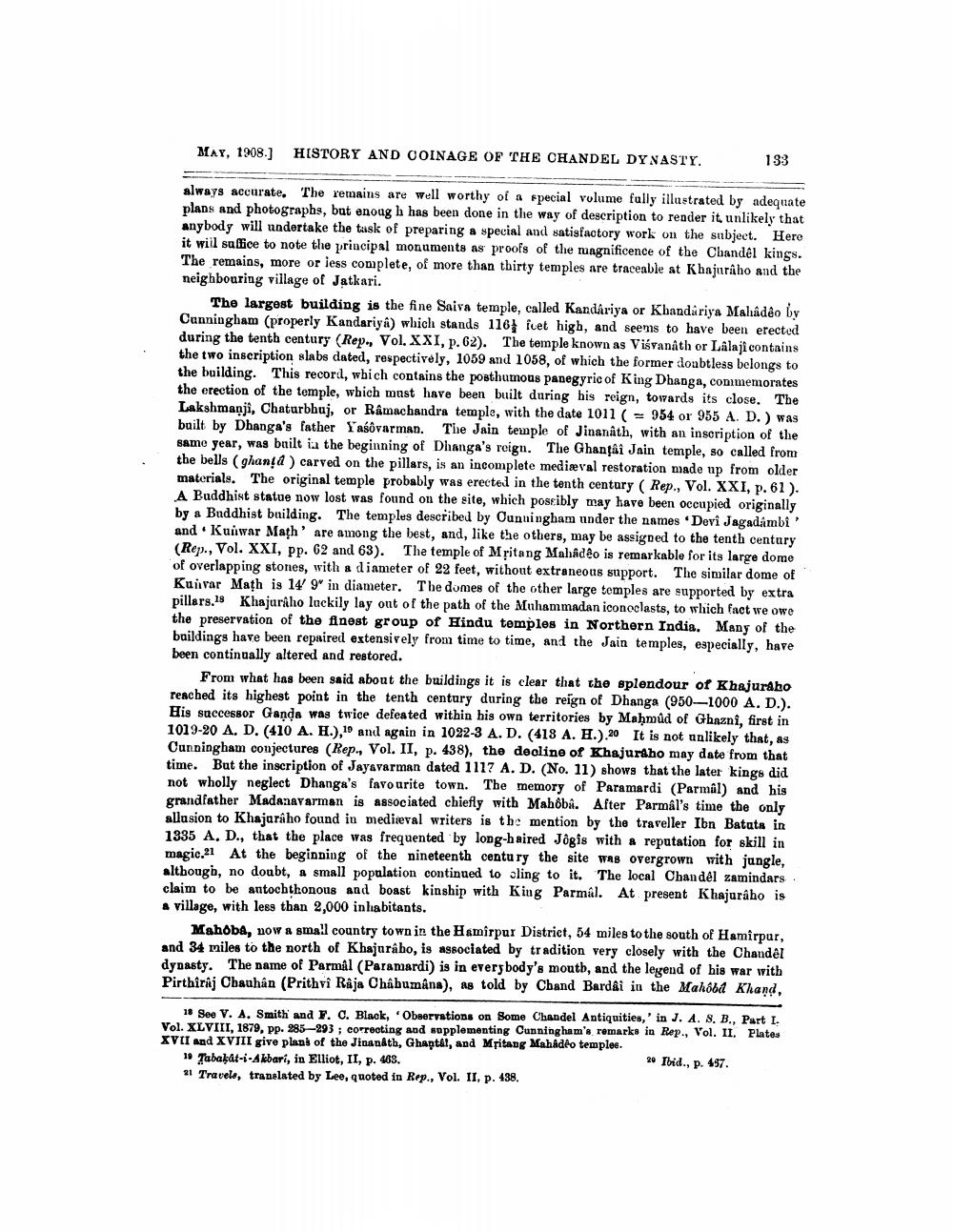________________
MAY, 1908.] HISTORY AND COINAGE OF THE CHANDEL DYNASTY.
133
always accurate. The remains are well worthy of a special volume fully illustrated by adequate plans and photographs, but enough has been done in the way of description to render it unlikely that anybody will undertake the task of preparing a special and satisfactory work on the subject. Here it will suffice to note the principal monuments as proofs of the magnificence of the Chandel kings. The remains, more or less complete, of more than thirty temples are traceable at Khajuraho and the neighbouring village of Jatkari.
The largest building is the fine Saisa temple, called Kandariya or Khandariya Malâdeo by Cunningham (properly Kandariya) which stands 116) fuet high, and seems to have been erected during the tenth century (Rep., Vol. XXI, p. 62). The temple known as Visvanath or Lalaji contains the two inscription slabs dated, respectively, 1059 and 1058, of which the former doubtless belongs to the building. This record, which contains the posthumous panegyric of King Dhanga, conmemorates the erection of the temple, which must have been built during his reign, towards its close. The Lakshmanji, Chatarbhaj, or Ramachandra temple, with the date 1011 ( = 954 or 955 A. D.) was bailt by Dhanga's father Yasóvarman. The Jain temple of Jinanath, with an inscription of the same year, was built ia the beginning of Dhanga's reign. The Ghanţâi Jain temple, so called from the bells (ghand ) carved on the pillars, is an incomplete mediæval restoration made up from older materials. The original temple probably was erected in the tenth century (Rep., Vol. XXI, p. 61). A Buddhist statue now lost was found on the site, which possibly may have been occupied originally by a Buddhist building. The temples described by Cunningham under the names Devî Jagadámbi' and . Kunwar Math' are among the best, and, like the others, may be assigned to the tenth century (Rep., Vol. XXI, pp. 62 and 63). The temple of Mritang Mahadeo is remarkable for its large dome of overlapping stones, with a diameter of 22 feet, without extraneous support. The similar dome of Kuivar Math is 14' 9" in diameter. The domes of the other large temples are supported by extra pillars.18 Khajuraho luckily lay out of the path of the Muhammadan iconoclasts, to which fact we owe the preservation of the finest group of Hindu temples in Northern India. Many of the buildings have been repaired extensively from time to time, and the Jain temples, especially, have been continually altered and restored.
From what has been said about the buildings it is clear that the splendour of Khajuraho reached its highest point in the tenth century during the reign of Dhanga (950—1000 A. D.). His successor Ganda was twice defeated within his own territories by Mahmûd of Ghazni, first in 1019-20 A. D. (410 A. H.),19 and again in 1022-3 A. D. (418 A. H.).20 It is not anlikely that, as Cunningham conjectures (Rep., Vol. II, p. 438), the decline of Khajuraho may date from that time. But the inscription of Jayavarman dated 1117 A. D. (No. 11) shows that the later kings did not wholly neglect Dhanga's favourite town. The memory of Paramardi (Parmal) and his grandfather Madanavarman is associated chiefly with Mahoba. After Parmal's time the only allusion to Khajuraho found in medieval writers is the mention by the traveller Ibn Batats in 1335 A, D., that the place was frequented by long-haired Jogis with a reputation for skill in magic.21 At the beginning of the nineteenth century the site was overgrown with jungle, although, no doubt, a small population continued to sling to it. The local Chandel zamindars claim to be antochthonous and boast kinship with King Parmál. At present Khajuraho is a village, with less than 2,000 inhabitants.
Mahoba, now a small country town in the Hamirpur District, 54 miles to the south of Hamirpur, and 34 miles to the north of Khajuraho, is associated by tradition very closely with the Chandel dynasty. The name of Parmal (Paramardi) is in everybody's mouth, and the legend of his war with Pirthiraj Chauhan (Prithvi Raja Châbumâna), as told by Cband Bardai in the Mahób Khand,
18 Soo V. A. Smithi and Y. O. Black, Observations on some Chandel Antiquities,' in J. A. 8. B., Part I. Vol. XLVIII, 1879, pp. 285-293 ; correoting and sopplementing Cunningham's remarks in Rep., Vol. II. Plates XVII and XVIII give plans of the Jinanáth, Ghaptal, and Mritang Mahadlo temples. 19 Tabakat-i-Akbari, in Elliot, II, p. 468.
20 lbid., p. 457 21 Travels, translated by Lee, quoted in Rep., Vol. II, p. 438.




